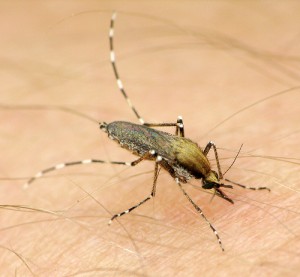It is safe to say that mosquito bites have been a nuisance for humans ever since the early days of our species, both in terms of the itchy and sometimes painful reactions we get and in terms of the vector transmitted diseases caused from such bites, ranging from malaria to yellow fever. But recent insect collecting trips to the Spring Creek Greenway Nature Center and Brazos Bend State Park for the lab portion of this course exposed me to a higher density of mosquitoes (and thus mosquito bites) than I am accustomed to living in the big city.
Our first collecting trip took place at the Spring Creek Greenway Nature Center, and for the three hours we were there, I did not notice a single Diptera species bite me. This was odd, not only because I did not apply any insect repellent, but also because many of my peers were complaining about how much they were getting bit. I began doing some research about this discrepancy, and found out that there are an abundance of factors that influence the reason why mosquitoes bite some people more than others.
According to an article published on the Smithsonian magazine’s website (http://blogs.smithsonianmag.com/science/2013/07/why-do-mosquitoes-bite-some-people-more-than-others/), factors that are thought to play a role in mosquitoes’ preference on whom to bite include blood type, the amount of carbon dioxide exhaled, metabolism, skin bacteria, blood alcohol content, pregnancy, clothing color, and other genetic factors.
For whatever the reason, however, our next trip to Brazos Bend State Park did not have the same result for me. I did not put on repellent, a decision that perhaps was a bit arrogant because I returned home bite-free the previous week. But boy, was I mistaken. Not only was I being bitten, but my shirt did not even serve as a barrier for the particular mosquito. It felt as if I was being eaten alive!
Although I did not capture and properly identify the species that was biting me through my shirt, I began to research what mosquito could have been overwhelming me at Brazos Bend when I returned to Rice – I could simply not stop itching, eventually draping my exterior into a slough of scabs. According to a World Health Organization pamphlet on mosquito biology and control measures (http://www.who.int/water_sanitation_health/resources/vector007to28.pdf), I learned that horseflies (Tabanidae) have the rare ability to bite through clothing. But I knew that I wasn’t being bitten by Tabanidae simply because the bites were not like the characteristically painful horsefly bites.
http://farm1.static.flickr.com/50/152742527_e7335f5819.jpg
So I continued to read about the subject and realized that Fort Bend and Harris Counties have succumbed to an invasion of salt marsh mosquitoes, or Aedes sollicitans, over the past few weeks. After the recent drought of 2011-2012, a few years’ worth of salt marsh mosquito larva were lying dormant. The ground must flood for these larvae to grow, so windy conditions that led to an elevation in tide level in early September allowed for ideal conditions for a mosquito population explosion (http://www.houstonchronicle.com/news/health/article/These-mosquitoes-eat-round-the-clock-4800349.php). This is the critter that I believe is to blame for incessantly biting me, even through my shirt. The salt marsh mosquito is known to be such a prevalent mammal bloodfeeder that this species was used to study the first mosquito repellents’ effectiveness (http://www.cabdirect.org/abstracts/19411000124.html;jsessionid=BA9AD7A67B4FD49A7200B474444C42AF#). This study was published in 1940, so we know that salt marsh mosquitoes have been annoying us to the point of forcing us to create a repellent specifically against them.
Oh yea, and it certainly did not help that I was wearing a red shirt, the perfect color to attract any species of bloodthirsty mosquito.

